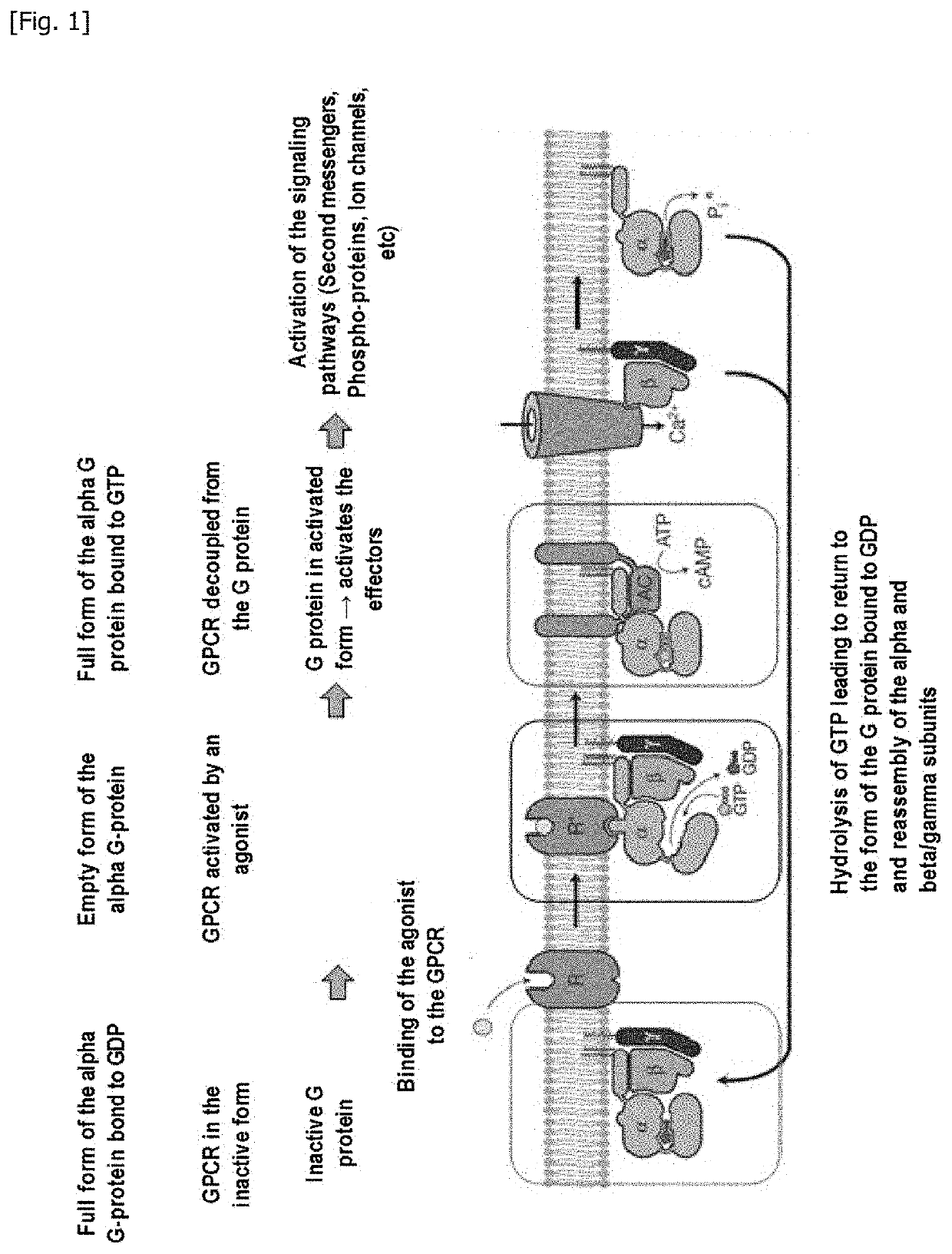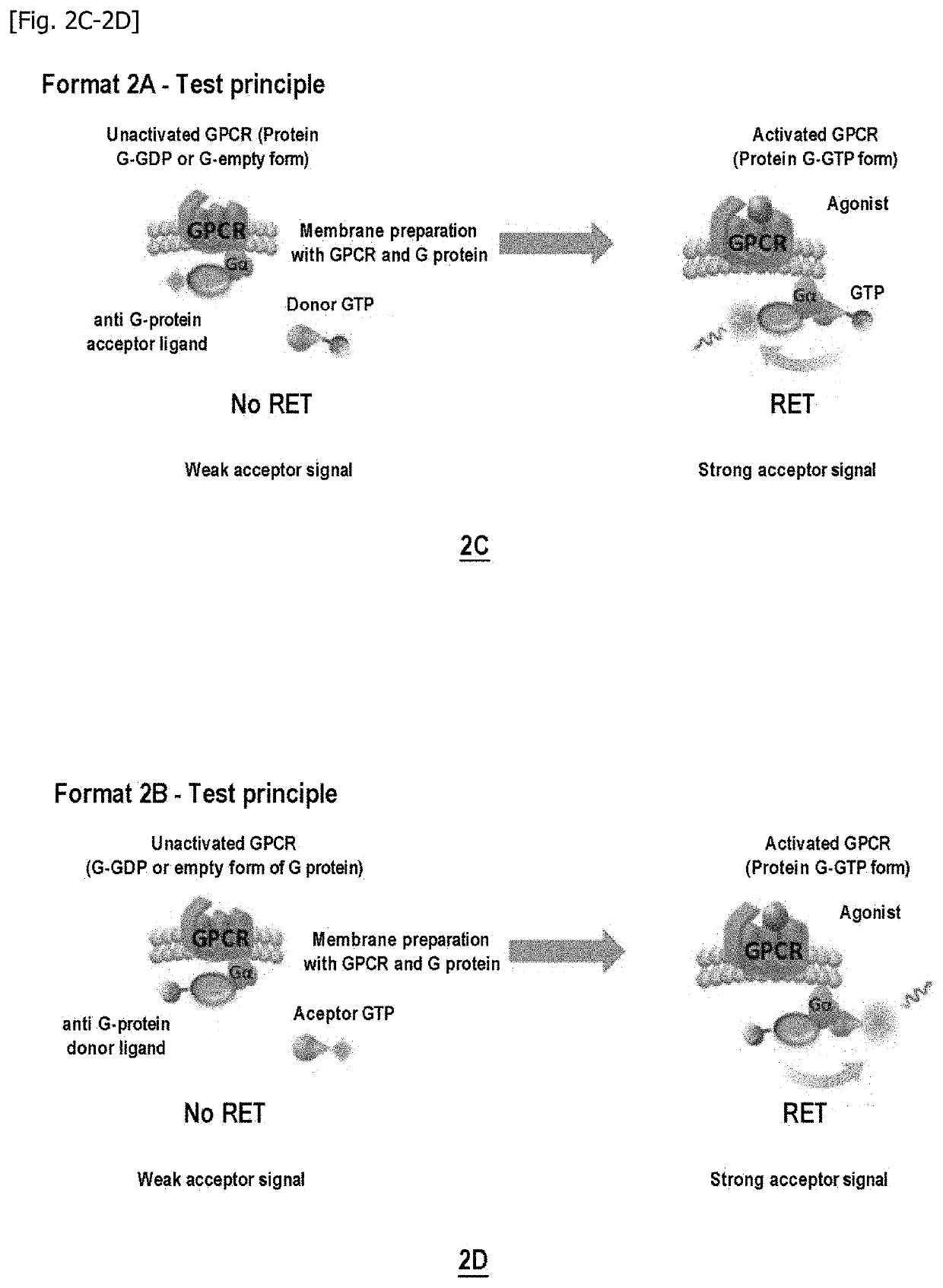Method for measuring the modulation of the activation of a g protein-coupled receptor with gtp analogues
- Summary
- Abstract
- Description
- Claims
- Application Information
AI Technical Summary
Benefits of technology
Problems solved by technology
Method used
Image
Examples
examples
[0239]Materials[0240]the cell membrane preparations expressing the receptors under investigation and the alphai G-protein were purchased from Perkin Elmer or Euroscreen. The following table lists the base cells and references of the various samples used:
TABLE 1BasecellSupplierReferenceDelta OpioidHEK293Perkin Elmer6110549400UADelta OpioidCHO-K1EuroscreenServiceDopamine D2SCHO-K1EuroscreenService[0241]the DSV36S and DSV38S antibodies were generated by Cisbio Bioassays and are available from Cisbio Bioassays on request (under the respective references DSV36S and DSV38S). The DSV36S antibody comprises a variable domain of the heavy chain that consists of the amino acid sequence SEQ ID NO: 14 and a variable domain of the light chain that consists of the amino acid sequence SEQ ID NO: 15. The antibodies were labeled with the fluorescent probes compatible for TR-FRET detection (acceptor red—d2 or donor Lumi4Tb). The two antibodies DSV36S and DSV38S bind at the level of the switch II domai...
examples 1 to 7
According to Format 1A on Delta Opioid GPCR (DOR): Decrease in the TR-FRET Signal Between GTP-Donor and G-Alphai Protein Acceptor Antibody Under Stimulation of an Agonist
[0269]Firstly, the capacity of the GTP-donor / anti-G-alphai acceptor antibody pairs for generating a specific TR-FRET signal on binding to the G protein was detected using HEK293 or CHO-K1 cell membrane preparations expressing the Delta Opioid GPCR and the Galphai protein. The following experimental conditions were used:[0270]Example 1 / FIG. 3A: GTPgN-octyl-C2 (6 nM final in the well); DSV36S-d2 (10 nM final in the well); 10μg CHO-DOR membranes / well; Buffer: TrisHCl 50 mM pH7.4; MgCl2 10 mM; NaCl 10 mM; BSA 0.1%.[0271]Example 2 / FIG. 4A: GTPgN-octyl-C11 (6 nM final in the well); DSV36S-d2 (10 nM final in the well); 10μg CHO-DOR membranes / well; Buffer: TrisHCl 50 mM pH7.4; MgCl2 10 mM; NaCl 10 mM; BSA 0.1%.[0272]Example 3 / FIG. 5A: GTPgO-hexyl-C2 (6 nM final in the well); DSV36S-d2 (10 nM final in the well); 10μg CHO-DOR...
example 8
the Concentration of Membrane and of GTP-Donor on the Activation Test According to Format 1A on Delta Opioid GPCR (DOR): Decrease in the TR-FRET Signal Between GTP-Donor and G-Alphai Protein Acceptor Antibody Under Stimulation of an Agonist
[0279]Firstly, the capacity of the GTPgN-octyl-C2 / anti-G-alphai DSV36S-d2 antibody pair for generating a specific TR-FRET signal on binding to the G protein was detected using CHO-K1 cell membrane preparations expressing the Delta Opioid GPCR and the Galphai protein (1 or 10 μg / well). GTPgN-octyl-C2 was used at 2 or 6 nM final in the wells. The membranes were incubated in the absence or in the presence of a large excess of GTPgS (100μM). The TR-FRET signal difference (HTRF Ratio) observed between these two conditions shows that the GTPgN-octyl-C2 analogue is capable of binding to the alphai G-protein and generating a TR-FRET signal with the anti G-alphai DSV36S-d2 antibody (FIG. 10A). Moreover, the panel on the left shows an increase in the signal...
PUM
 Login to View More
Login to View More Abstract
Description
Claims
Application Information
 Login to View More
Login to View More - R&D
- Intellectual Property
- Life Sciences
- Materials
- Tech Scout
- Unparalleled Data Quality
- Higher Quality Content
- 60% Fewer Hallucinations
Browse by: Latest US Patents, China's latest patents, Technical Efficacy Thesaurus, Application Domain, Technology Topic, Popular Technical Reports.
© 2025 PatSnap. All rights reserved.Legal|Privacy policy|Modern Slavery Act Transparency Statement|Sitemap|About US| Contact US: help@patsnap.com



